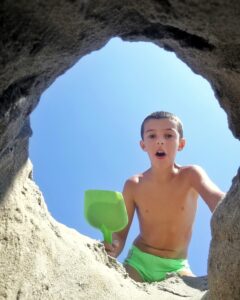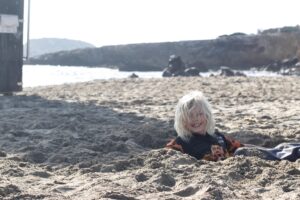As summer approaches, we begin to think about the warm weather, sunshine, and of course vacations. Virginians are lucky to have numerous beautiful beaches along our coastline.

Many of us will plan a trip to the beach this summer, even if only a day trip. In preparing for a beach vacation, we obviously pack things like towels and swimsuits, and worry about things such as sunburn, dehydration, and yes… thanks to the 1975 blockbuster movie JAWS, we worry about sharks.
But who among us worries about sand during a beach trip? I would guess very few! If you were told you were more likely to die in a collapsed sand hole or tunnel at the beach than from a shark attack, would you believe it?
Shark attacks vs. sand holes
According to a 2007 study in the New England Journal of Medicine (by Dr. Bradley Maron of Harvard Medical School and his father Dr. Barry Maron), there were 16 sand hole or tunnel deaths in the U.S. from 1990-2006. During that same timeframe, there were only 12 fatal shark attacks, as reported by statistics from the University of Florida. According to Bradly Maron, the sand hole and tunnel-related deaths are likely not well-documented. This is because they do not grab the attention of media consumers like a shark attack would. Yet the threat is real and not to be ignored.

As a matter of fact, just this year, a 17-year-old boy from Chesapeake, Virginia, was killed in the Outer Banks beaches of North Carolina. He was buried under several feet of sand after an adjacent sand dune collapsed into a hole that was dug in the sand.
So how does one get trapped in a sand hole or tunnel? And how does the situation become fatal?
Typically, when a hole is dug into dry sand, even if it is just a few feet deep, it can collapse. Sand holes are a completely unstable environment; sand does not stay in one place, and the walls of the hole will not hold. Once the collapse begins, it happens incredibly fast. The sand then piles on top of the person and traps them in the hole. Finally, the weight of the sand makes it difficult to breathe and/or it can enter the lungs. The brain and other organs then become deprived of oxygen. Often rescuers are not able to extract the victim from the hole in time, and the victim suffocates.

How to prevent sand hole traps
How can we prevent tragedies like the one described above from happening again?
- Never let young kids play in sand unattended.
- Never get in a hole deeper than your knees.
- If you dig a hole in the sand, fill it in completely afterward.
- Listen to lifeguards (who will often warn beachgoers about digging large holes).
- Never put your head below sand level.
- Avoid digging or tunneling into the side of a sand dune or berm.
Summer is a time to get outside, be carefree, and plan a trip to the beach. Prepare to make memories with your family by building a sandcastle and laying in the sand, absolutely. Just be sure that all members of your party are aware of the hidden dangers that lie just beneath the tranquil beach surface. By making yourself aware of the dangers of sand hole collapses, you can enjoy your vacation and prevent a serious tragedy from happening.
And if you or a loved one have been injured through no fault of your own, you can have a free case evaluation today by calling Allen & Allen, at 866-388-1307.



